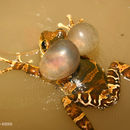en
names in breadcrumbs


Trachycephalus typhonius is common and widespread across Central and South America.It occurs from the lowlands of tropical Mexico, along both coasts of Central America to Nicaragua, then in the Pacific lowlands to Panama.The species extends into the Amazon Basin of Colombia, Ecuador, Peru, Bolivia, Venezuela, and Brazil, the Guianas, Brazil south to Paraná, Paraguay, northern Argentina and Trinidad and Tobago. It has an altitudinal range in South America of sea level to 800 m asl, up to 1610 m asl in Central America (La Marca et al. 2010) and in Guatemala it is found to 2500 m asl (Frost 2015).
The veined tree frog, Trachycephalus typhonius, is a common and widespread hylid treefrog inhabiting Central and South American forests, forest edges, plantations, savannahs, including disturbed habitats and houses from southern Mexico to northern Argentina.It has a complex taxonomic history, with a recent name change from T. venulosa to T. typhonius (to recognize the senior synonym of Rana venulosa Laurenti, 1768; see Lavilla et al. 2010, Frost 2015).
Much is known about this large (up to 11.5 cm snout vent length), yellow- to tan- to red brown- to grey-colored treefrog.It is nocturnal, and forages and shelters in tree holes, leaf sheathes, crevices in bark, and bromeliads (Prus 2008).Adults can parachute from trees by spreading their legs and gliding up to a reported 27 m (Cott 1926, Oliver 1951, as cited in Prus 2008).In the rainy season, adults congregate around warm, slow temporary water sources to breed explosively.Males inflate large vocal sacs to make advertisement calls while floating on the water surface; recordings can be heard here: http://www.fonozoo.com/fnz_detalles_registro_amphibia.php?id=100099&tipo_registro=1.Females lay eggs in a film on the water surface.Tadpoles hatch after one day, feed on planktonic algae or by scraping algae from surfaces, and have large gills adapted for low oxygen levels. Metamorphosis to adult stage is complete 37-47 days after eggs are laid (Prus 2008).
The skin of adult veined tree frogs contains granular glands that secrete copious amounts of sticky, milky mucus when the frog is disturbed.Neck glands are particularly large with mucus during the dry season; in addition to deterring predators with the poisonous, alkaline mucus, frogs also use it to cover themselves and line their nests in the dry season, when the water-insoluble mucus helps prevent desiccation.Human reactions to contact with the mucus can be severe.It causes swelling, pain and even temporary blindness when in contact with the eyes (La Marca et al. 2010; Prus 2008).